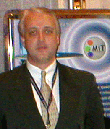|
|
 
|
|
Author
|
Topic: ETC Screens Digitally Restored "Wizard of Oz"
|
Bevan Wright
Expert Film Handler

Posts: 176
From: Fountain Valley, CA, USA
Registered: Sep 2003
|
 posted 12-02-2005 07:11 AM
posted 12-02-2005 07:11 AM





ETC Screens Digitally Restored "Wizard of Oz"
By Staff
Nov 29, 2005, 16:37
The Entertainment Technology Center at will be holding a screening of the digitally restored version of "Wizard of Oz" on Monday, December 5, 2005 at 7:00 PM.
"Wizard of Oz" is the first classic film scanned and restored at 4K using Warner Bros. patent-pending Ultra-Resolution software. This "Wizard of Oz" presentation has greater visual clarity than the original Technicolor release, and far surpasses later versions that suffered from deformities to the original nitrate negatives. Using the Ultra-Resolution software, the Warner Bros. team precisely aligned the original 3-Strip negatives as well as captured the glorious Technicolor palette of the initial dye transfer prints. "Wizard of Oz" will be exhibited with Christie's 2K DLP Cinema projector.
Learn how "Wizard of Oz" was restored for the recent Collector's Edition and Special Edition DVD releases during the Q&A following the screening.
Guest speakers:
Chris Cookson, president, Warner Bros. Technical Operations; CTO, Warner
Bros. Entertainment, Inc.
Rob Hummel, senior vice president, production technologies, Warner Bros.
Advanced Media Services
WHERE: Digital Cinema Laboratory at the historic Hollywood Pacific Theatre
6433 Hollywood Blvd., between Cahuenga and Wilcox
Public parking on Wilcox, south of Hollywood Blvd.
| IP: Logged
|
|
|
|
|
|
|
|
|
|
|
|
|
|
|
|
|
|
Stephen Furley
Film God

Posts: 3059
From: Coulsdon, Croydon, England
Registered: May 2002
|
 posted 12-04-2005 04:09 AM
posted 12-04-2005 04:09 AM




quote: Carl Martin
the highlights had that harsh look that you get with material shot on video or put through a digital intermediate.
I've seen this on quite a few films; 'The Constant Gardener', which I ran for two shows yesterday, for example. I think it looks horrible. However, I've also seen digital work which doesn't look like this, so there would seem to be two possibilities:
1. It's just bad digital work.
or
2. That was the look they wanted for the film.
Anyone care to comment?
quote: John Pytlak
As always, the advantage of using all the available pixels (or image area on a film print) are light efficiency and sharpness.
Of course, the idea of cropping, and wasting a large part of the available image area is nothing new; we've been doing it for about 50 years for widescreen films, and it was proposed, but not generally adopted, in the '20s, as a cheap alternative to the wide-film processes then being introduced. I still think that it's a pretty dumb idea, unless you need a non-standard aspect ratio for some reason, e.g. the 2:1 35mm anamorphic reduction prints of 'The Big Trail'.
About the worst example I can think of would be the many scope films which were released in the '70s and '80s, as non-anamorphic 16mm prints, slightly cropped at the sides, and with the frame matted to something slightly wider than 2:1. Yet another reason why 16mm has a (undeserved) bad reputation.
| IP: Logged
|
|
|
|
|
|
|
|
|
|
|
|
All times are Central (GMT -6:00)
|
|
Powered by Infopop Corporation
UBB.classicTM
6.3.1.2
The Film-Tech Forums are designed for various members related to the cinema industry to express their opinions, viewpoints and testimonials on various products, services and events based upon speculation, personal knowledge and factual information through use, therefore all views represented here allow no liability upon the publishers of this web site and the owners of said views assume no liability for any ill will resulting from these postings. The posts made here are for educational as well as entertainment purposes and as such anyone viewing this portion of the website must accept these views as statements of the author of that opinion
and agrees to release the authors from any and all liability.
|

 Home
Home
 Products
Products
 Store
Store
 Forum
Forum
 Warehouse
Warehouse
 Contact Us
Contact Us




 Printer-friendly view of this topic
Printer-friendly view of this topic







![[Frown]](frown.gif)






![[Wink]](wink.gif)




